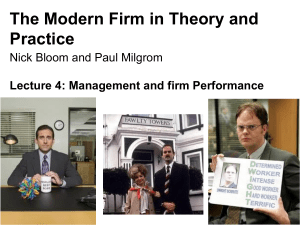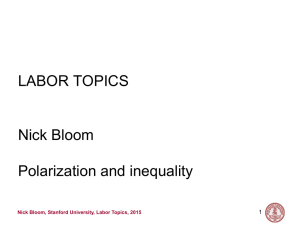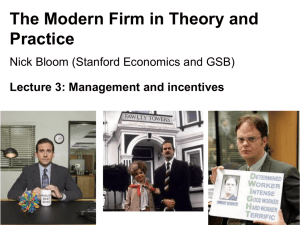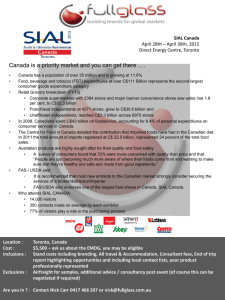Lecture 7
advertisement
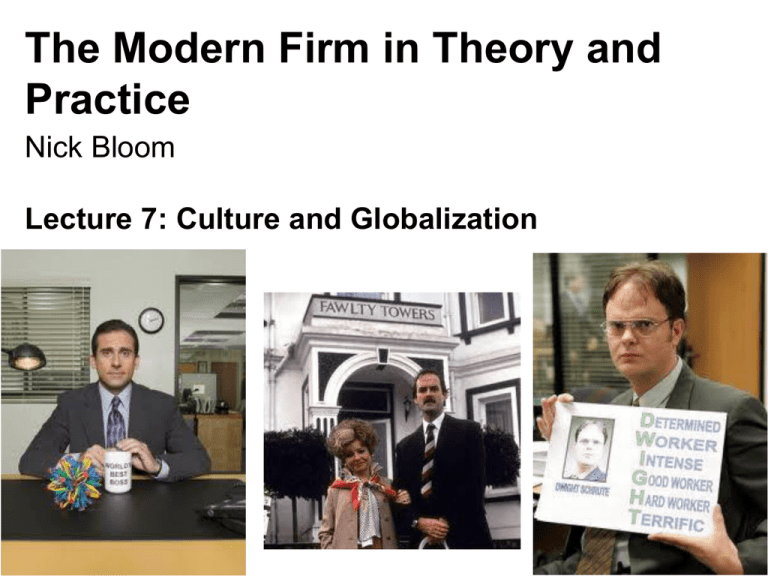
The Modern Firm in Theory and Practice Nick Bloom Lecture 7: Culture and Globalization Nick Bloom, 149, 2015 1 Lincoln Venturing Abroad Targets management practices Cemex Nick Bloom, 149, 2015 2 Case introduction https://www.youtube.com/watch?v=EftYWQOs_cU Nick Bloom, 149, 2015 3 What made Lincoln so unusual in the US context? Nick Bloom, 149, 2015 4 What challenges did Lincoln face in trying to take its system abroad? Nick Bloom, 149, 2015 5 Is Lincoln’s system a good approach for other US (manufacturing) firms to follow Nick Bloom, 149, 2015 6 Lincoln Venturing Abroad Targets management practices Cemex Nick Bloom, 149, 2015 7 (9) Target interconnection Score (1): Goals are based purely on accounting figures (with no clear connection to shareholder value). Nick Bloom, 149, 2015 (3): Corporate goals are based on shareholder value but are not clearly communicated down to individuals (5): Corporate goals focus on shareholder value. They increase in specificity as they cascade through business units ultimately defining individual performance expectations. Target interconnection (9): all countries, manufacturing .2 0 .1 Density .3 .4 Average 3.01 1 2 3 Target interconnection 4 5 All countries, manufacturing firms (100 to 5000 employees), 9 9813 observations Nick Bloom, 149, 2015 (10) Target time horizon Score (1): Top management's main focus is on short term targets . Nick Bloom, 149, 2015 (3): There are short and long-term goals for all levels of the organization. As they are set independently, they are not necessarily linked to each other (5): Long term goals are translated into specific short term targets so that short term targets become a "staircase" to reach long term goals Target time horizon (10): all countries, manufacturing .2 0 .1 Density .3 .4 Average 2.99 1 2 3 Target time horizon 4 5 All countries, manufacturing firms (100 to 5000 employees), 11 9814 observations Nick Bloom, 149, 2015 (11) Targets are stretching Score (1): Goals are either too easy or impossible to achieve; managers provide low estimates to ensure easy goals Nick Bloom, 149, 2015 (3): In most areas, top management pushes for aggressive goals based on solid economic rationale. There are a few "sacred cows" that are not held to the same rigorous standard (5): Goals are genuinely demanding for all divisions. They are grounded in solid, solid economic rationale Targets are stretching (11): all countries, manufacturing .2 .1 0 Density .3 .4 Average 3.00 1 2 3 Targets are stretching 4 5 All countries, manufacturing firms (100 to 5000 employees), 13 9819 observations Nick Bloom, 149, 2015 (12) Performance clarity Score (1): Performance measures are complex and not clearly understood. Individual performance is not made public Nick Bloom, 149, 2015 (3): Performance measures are well defined and communicated; performance is public in all levels but comparisons are discouraged (5): Performance measures are well defined, strongly communicated and reinforced at all reviews; performance and rankings are made public to induce competition Performance clarity (12): all countries, manufacturing .2 .1 0 Density .3 .4 Average 2.67 1 2 3 Performance clarity 4 5 All countries, manufacturing firms (100 to 5000 employees), 15 9821 observations Nick Bloom, 149, 2015 Lincoln Venturing Abroad Targets management practices Cemex Nick Bloom, 149, 2015 16 Some typical cement plants – capital intensive Suwanee, Georgia Nick Bloom, 149, 2015 Sumterville, Florida Another cement plant (RMC’s Rugby plant) As an example, he pointed to RMC’s Rugby plant in England. This facility had become notorious for its inefficiency and was importing sizable quantities of cement from competitors to keep pace with its ready-mix demand prior to the CEMEX deal. Within just three months, CEMEX was able to improve operational efficiency (as measured by kiln utilization) from 74 to 90 percent and reduced significantly the plant’s need to import cement. Nick Bloom, 149, 2015 Cemex stock has done OK, but not great Nick starts teaching case in Econ 149 S&P Lafarge Nick Bloom, 149, 2015 Nick Bloom, 149, 2015 20 Cemex top 4 outside China (in 2011) Nick Bloom, 149, 2015 China dominates global cement production Nick Bloom, 149, 2015 Cement (in the US) also a history of labor issues “No other industrial workers in the country can point to contracts that impinge on and restrict the rights of management as much as cement contracts do.” President of the Cement, Lime and Gypsum Workers Union, in 1978 from VOICE (the monthly union magazine) Nick Bloom, 149, 2015 Q1) Why are global companies emerging in the cement business? What is the advantage of being global in this business? Nick Bloom, 149, 2015 24 Q2) How does the theory of the firm help us understand the Cemex case? How does this case call the theory into question? Nick Bloom, 149, 2015 25 Q3) After gaining scale in Mexico, Cemex enters Spain. Why did many doubt Cemex’s ability to add value to the Spanish acquisitions? What did Cemex find out about itself in this process? Nick Bloom, 149, 2015 26 Q4) What do you make of Cemex’s acquisitions? Should it enter China and India? Nick Bloom, 149, 2015 27 Concrete rider (from New Zealand) Nick Bloom, 149, 2015 Wrap up 1) Managing international expansions is hard: need experience 2) Challenges around variations in • Regulations • Unions and working norms • Culture and language 3) Successful example from Cemex focused around starting locally (culturally near – e.g. Spanish speaking) and expanding 4) Lincoln initially struggled with a too rapid expansion Nick Bloom, 149, 2015 29



